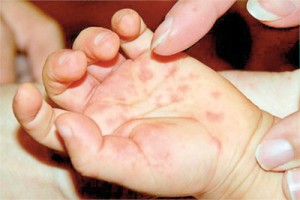Sore mouth: A tell-tale sign
View(s):Fever, body aches and pains and a sore mouth are the signs of this very contagious but not dangerous illness. Affecting mainly pre-schoolers or under-fives, hand-foot-and-mouth disease is in no way linked to the foot-and-mouth disease spreading among animals in the country, reiterates Consultant Paediatrician Dr. R. Ajanthan.

Consultant Paediatrician Dr. R. Ajanthan
 Allaying fears, he is quick to point out that the disease in animals and the malaise among children are “two separate entities”. Hand-foot-and-mouth disease in children is a viral infection which manifests the symptoms of fever, body aches and pains and sores in the mouth which include ulcers on the palate. There could also be a rash on the palms, soles, elbows and buttocks, MediScene learns.
Allaying fears, he is quick to point out that the disease in animals and the malaise among children are “two separate entities”. Hand-foot-and-mouth disease in children is a viral infection which manifests the symptoms of fever, body aches and pains and sores in the mouth which include ulcers on the palate. There could also be a rash on the palms, soles, elbows and buttocks, MediScene learns.
When little ones have a sore mouth, the difficulty is to get them to eat and drink, as there is a lot of discomfort and pain, says Dr. Ajanthan, urging a diet of soft foods such as jelly with minimal colouring, custard and kenda or kanjee. “The answer is not to cause further irritation.” Give semi-solid food which is less spicy, in small quantities at frequent intervals, he says, strongly advising parents against force-feeding the child which may lead to coughing and vomiting.
Lots of fluids should be given, according to him, and not just plain water but those with salt and nutrition. Referring to the rash that may come about due to hand-foot-and-mouth disease, Dr. Ajanthan says the blisters could be macule (there is a colour-change), papule (elevated) or vesicle (filled with fluid).
While the fever should be managed with paracetamol, local applications such as teething gels would ease the discomfort of a sore mouth, it is understood.Spread through the faeco-oral route, the germs could be airborne due to an infected child coughing or sneezing. The other ways in which the disease spreads are through close contact with blister fluid or through faecal matter, says Dr. Ajanthan, explaining that the incubation period is under five days.
“It happens very fast and the infected child becomes very ill within a short period. In other countries, day-care centres are closed to pre-empt an epidemic as this disease spreads rapidly,” he says, adding that frequent hand-washing is a major preventive measure.If there is persistent high fever not responding to paracetamol, poor intake of food for a long time, not passing urine for 12 hours or repeated vomiting, it would be time to take the child to the doctor, MediScene learns.
Usually, antibiotics are not prescribed for hand-foot-and-mouth disease, but if the child tends to scratch the rash and that gets infected the doctor may decide to give a dose of antibiotics, says this paediatrician. With the fever settling in about five days but the rash taking about two weeks to go away, Dr. Ajanthan requests parents to have a lot of patience.
It’s different from chicken-pox
Is it hand-foot-and-mouth disease or chicken-pox?
Blisters being very much a part of these illnesses, Dr. Ajanthan who concedes that there could be a misconception about what illness ails the child, shows the pathway to differentiating between the two.
The location of the blisters will be the pointer, he says, adding that chicken-pox blisters start in the centre of the body and spread to the extremities while in hand-foot-and-mouth disease they start in the extremities.



